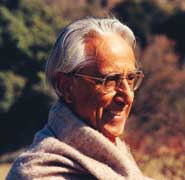




Christophany
Christophany is the manifestation of Christ to human consciousness; and includes an experience of Christ and a critical reflection of that experience” (The Fullness of Man, New York – Delhi 2006).
Christ is the direct manifestation of God to human consciousness and is – as the title of one of the latest books of R. Panikkar states – “the fullness of man”, “the real symbol of divinization”, the visible and public manifestation of the truth of Christ, which is not tied exclusively to Christianity:
“Christ is the fullness of life, this Fullness, that has so many names, is called in the Christian tradition Jesus the Christ… .. It belongs to the Christian kairos of the third millennium… .. to go beyond abrahamic monotheism without thereby questioning the legitimacy and validity of the monotheistic religions. This going beyond does not mean the negation of the divine, but rather opening to the great intuition of the Trinity (The Fullness of Man).
Christophany, therefore, is more than Christology. Besides attempting to elaborate a reflection on Christ and human being with clear reference to the Trinity, Panikkar is conscious that Christology is commonly a Western product linked to a concrete culture and has acted solely from within this brand. Today’s Christology “is not catholic, that is, is not universal”, and only by opening itself to other cultures and religions can it truly be so. Further, Christology cannot be a part of theology and of knowledge, a fragment of the all.
Christophany is the Christian reflection that the third millennium must elaborate.
- It does not claim to offer a universal paradigm, nor even necessarily a model to adopt, but rather simply to offer to all humanity a believable image of Christ.
- It is a Christian word yet opened to the universal problematic in a concrete and thereby limited way.
- The word is used in the sense of “phaneros of the Christian scriptures”, visible and public manifestation of a truth. Christ is the direct manifestation of God to human consciousness and represents an experience.
- Christophany does not ignore nor claim to abolish the preceding christology, but christophany rather tries to situate itself in a continuity with christology in order to deepen it.
- Christophany “suggests that the encounter with Christ can not be reduced to a mere doctrinal or intellectual approach”; it wants to elaborate a reflection on Christ and the human being with clear reference to the Trinity: “The logos is also the Logos of God, but the Logos is not “all” of the Trinity, and the Spirit, although it may be inseparable from the living Christ, is not subordinate to the Logos”. The Christo-phany does not take anything away from the Christo-logy, but shows itself opened to the reality of the Spirit.
- This contemplative, mystic attitude situates christophany in a more receptive posture, in contrast to the more aggressive search on the part of reason.
- This notion of Christ must include both the figure from the historic past as well as the present reality. Panikkar does not dispense with the historic Jesus, but Christ is not reduced to him (“Christ does not belong only to the past”). Christophany is a reflection opened to the Christian scriptures, but is in dialogue with the other religions; opened to dialogue with the past (even the pre-Christian) and with the present (even the non-Christian) and in particular the contemporary scientific mentality.
- Christophany, therefore, does not exclude a priori any epiphany of the sacred or the divine when searching for an integration of the figure of Christ in a more spacious cosmovision.”
official site